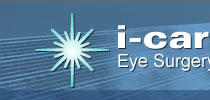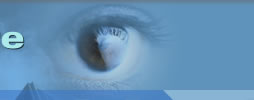How do Cataracts
Affect Sight?
The lens is normally clear so light can readily pass through it,
producing a sharp image on the retina; when the lens becomes opaque,
light can't pass through as easily. Having a cataract is like trying
to look through a foggy window.
The cloudy lens blocks the passage of light, thereby casting a
blurred image on the retina. Clouding of the lens may affect only
a small portion of the lens, or may affect the entire lens.
Cataract formation may cause little or no visual problem for some
people, especially in the early stage of the problem, but other
experience a substantial decrease in vision that may requires surgery.
Severe Cataracts may cause a complete loss in functional vision.
The degree to which a person's vision is affected by cataract formation
depends on the location and degree of clouding. For instance, if
the area clouding initially starts at the side of the lens, a person's
vision may not be drastically affected for years, because peripheral
vision is not used as mush as the central area. Cataracts typically
develop in both eyes, although the rate of progression varies with
each eye. The Onset of a cataract may be gradual or rapid. Cataracts
Usually develop around age 50, but may not significantly interfere
with sight until much later -age 65 to 75.
Clearing Up Cataract Myths.
- Cataracts do not "spread" from one eye to the other.
- Cataracts are not caused from overusing eyes.
- Cataracts are neither contagious nor related to cancer.
- There is no known means of reversing the clouding once it occurs.
- Cataracts are not a film or coating on the surface of the eye
Can Cataracts be Prevented?
There is no known prevention for cataracts that occur as a natural
process of aging. However, there is growing evidence that exposure
to Ultraviolet light (sunlight) and cigarette smoking may speed
their development. Avoidance of excessive sun exposure and smoking
is a sound preventative measure.
How are Cataracts Diagnosed?
A comprehensive eye health examination is needed to detect cataract
formation. After diagnosis, regular follow-up care is needed to
assure the best possible correction for the level of impairment.
What is the Treatment for Cataracts?
Prescription glasses can help you to see better. At some time,
however, cataract may become so dense that the good vision can no
longer be maintained with just prescription eyewear. At that time,
surgery may be the best option to restore vision.
The decision regarding surgery is one that is made jointly by the
patient and their eyecare professional. The decision of when to
have a cataract removed depends on a number of factor, such as the
extent of clouding, the location of the cataract, and the extent
to which normal daily activities are impaired. For instance, if
reading or driving abilities are impaired, surgery may be a more
realistic consideration than if such impairments have not yet been
noticed.
What Does Cataract Surgery Involve?
Cataract surgery has improved dramatically in the last decade with
a very high success rate - 95 percent or better. Over one million
cataract surgeries are performed annually. The surgery has few complications
and an increasingly short recovery time. Most of the time, the procedure
is done on an outpatient basis. |



